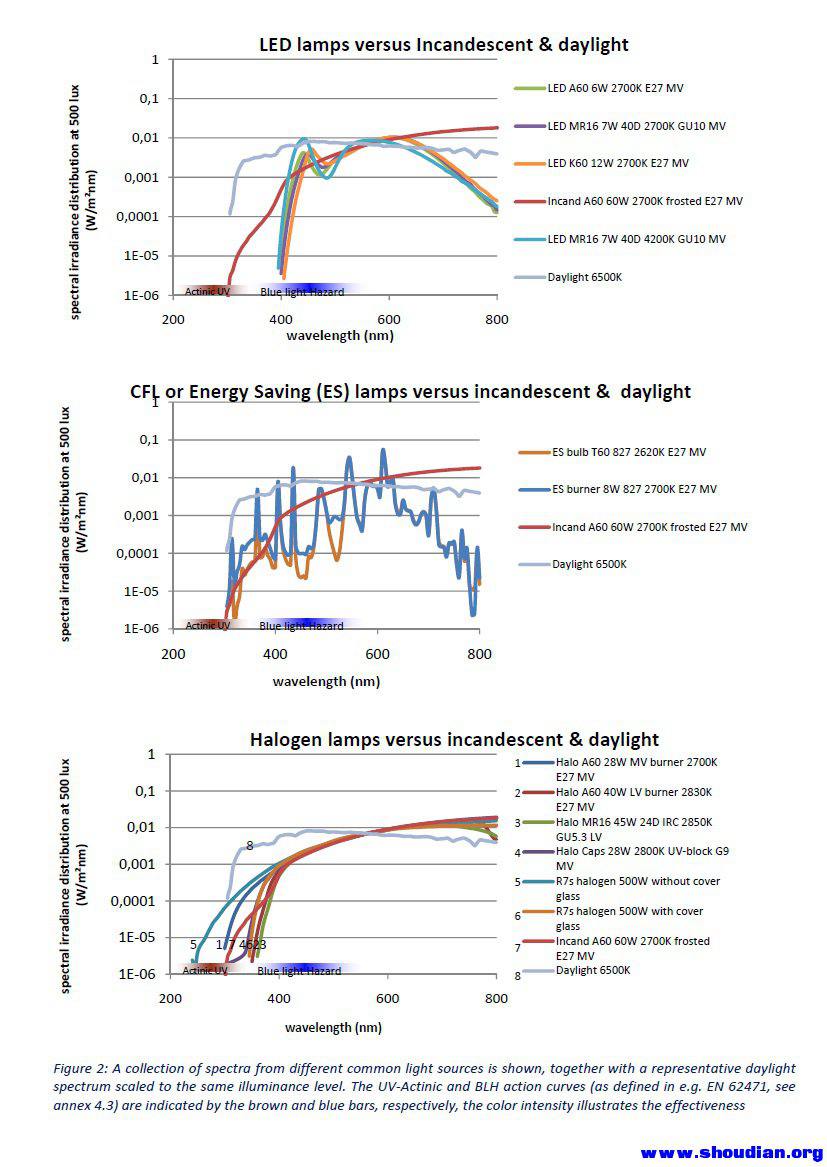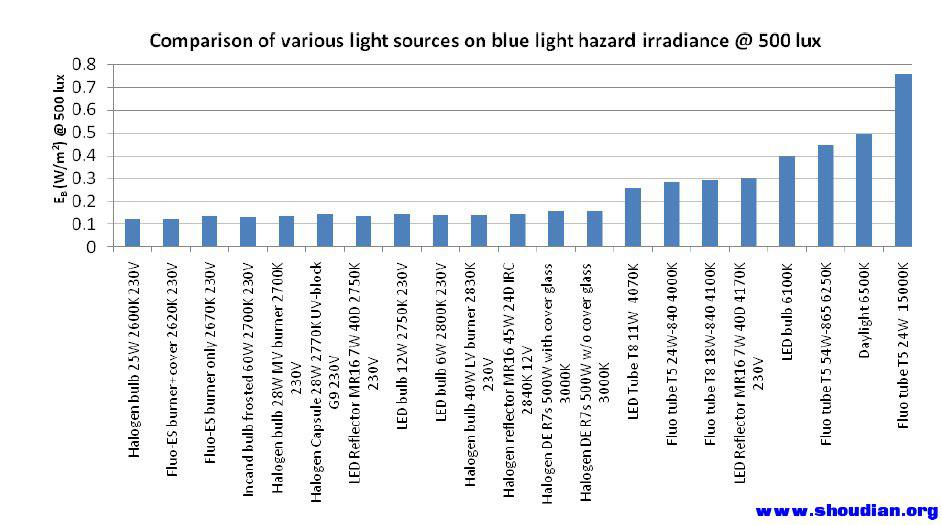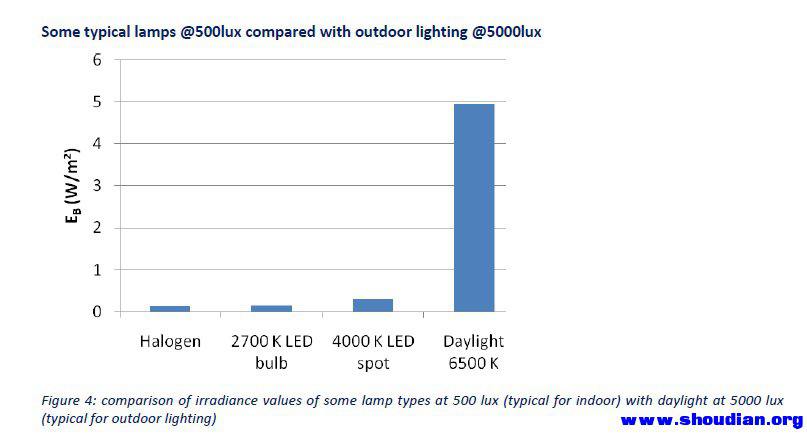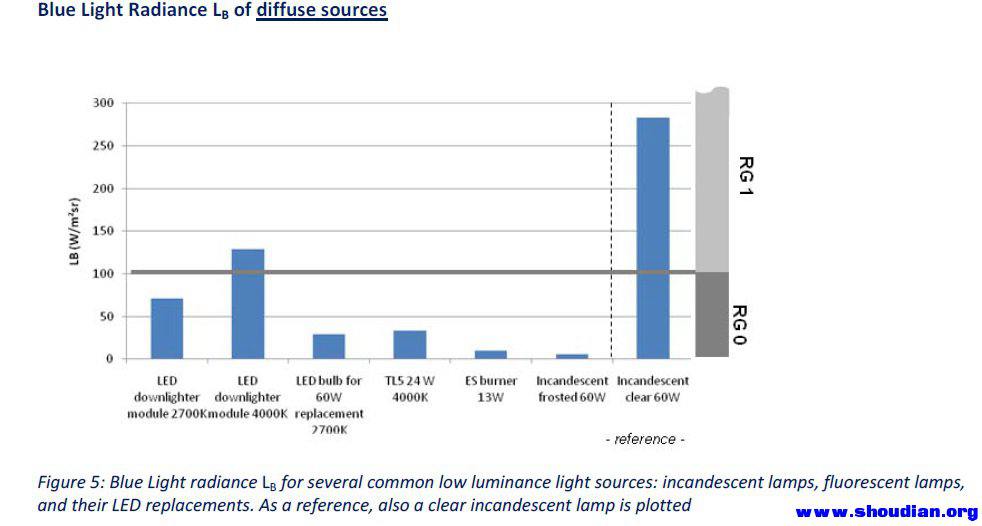|
|
本帖最后由 notooth 于 2013-8-28 09:43 编辑
先说说我个人观点,我的语文是体育老师教的,各位民科们就别鸡蛋里挑石头,咬文嚼字了
1、蓝光是对眼睛是有伤害我从来没否认过(高强度下),但是从物理层面上来讲,蓝光所造成的物理伤害和其他色光的区别仅仅来源于其光子能量差异,但是在实际效果上,我个人认为蓝光并没有比其他色光厉害太多,例如红外加热,我个人认为比蓝光伤害要厉害,因为很容易被人忽视。这也是我一直反对把蓝光单独提出来说什么比其他光线伤害巨大的最主要原因。
2、当前外界认为蓝光对眼睛伤害比其他色光厉害是因为这样两个原因:一是因为蓝光会促进眼内一些化学反应,二是因为人眼对蓝光聚焦比其他色光更厉害,尤其小孩子眼睛聚焦效率更高。这两个因素我不否认,但是我持保留意见,还是我重复了无数遍的:这些促进的程度应该和光强有联系,光强不够一切都是白扯。而且其他色光也有相对应的化学反应促进效应,我个人认为同样高强度光线照射下,蓝光比其他色光伤害差异并没有想象的那么大。这也是我昨天转的一个论文里面的观点The Long-term Effects of Visible Light on the Eye(不知道为什么被删除了,文章里面专门考量了长期暴露于紫外线,蓝关和高强度可见光下的情况,最后结论是没有发现这几个之间有什么大的差异,都会造成老年人的眼部疾病)
3、长时间暴露于高强度蓝光里面会对人眼造成严重伤害(注意是高强度),但是家用led照明里面的蓝光并不会有特别的伤害,因为强度远远到不了伤害的程度。
4、led灯具不是完美的,但绝对是当前最好选择
下面来重头戏,看看欧盟和法国的相关组织的观点,这两天读了10几个pdf,加起来都快100页了
先说法国
法国French Agency for Food, Environmental and Occupational Health & Safety为了了解led照明灯具是否对消费者造成伤害,组织了一个专家团,包括国家健康与医学研究院,照明协会,皮肤癌研究院,自然历史博物馆……等一大堆机构的负责人和教授,历时一年,最后给出led照明是安全的结论,和其他日常使用灯具并没有什么不同,并给led灯具划分了其所在安全等级。
按照欧盟的等级,照明灯具的risk group 划分为4类:Exempt(豁免,也叫RG0),RG1,RG2和RG3。除了少数超高色温的在2里面,led大部分灯具都在group 1之内。太阳是在group 3之内的,group 1是什么概念呢,就是理论上安全,可以安装在任何位置,包括孩子房间。咱们现在日常使用的白炽灯,日光灯,节能灯都在这个group里面。
再来说说欧盟的灯具和照明协会ELC/CELMA,欧盟委托他们进行研究,他们不但下结论说led照明是安全的,还说led里面的蓝光恰恰是现代人类所欠缺的(现代人类户外活动大幅度减少,白天室内蓝光也会欠缺),led正好补上了这个欠缺,对人体是有益的
下面直接引用其部分结论
Summary statement
It is often emphasized that LED based light sources are different from traditional lamps in that they contain
higher proportions of blue wavelength light and are thus more likely to cause problems such as blue light
hazard. Confronted with this question, the European Lighting Industry represented by ELC & CELMA,
presents a detailed evaluation of the photo biological safety of common LED light sources for domestic use
in comparison to traditional lamps. The focus is on white light sources used in households.
To summarize the key findings, LED sources (lamps or systems) and luminaires are safe to the consumer
when used as intended. In terms of their level of photo biological safety, LED lamps are no different from
traditional technologies such as incandescent lamps and fluorescent tubes(总的来说,led光源(灯泡和照明系统)以及灯具如同预期一样对消费者是安全的。在光学生物安全层级上,led灯泡和传统的白炽灯荧光灯没有什么不同). The portion of blue in LED is not
different from the portion of blue in lamps using other technologies at the same colour temperature.(同样色温下led的蓝光部分和使用其他技术的灯具没有什么不同) A
comparison of LED retrofit products to the traditional products they are intended to replace reveals that the
risk levels are very similar and well within the uncritical range.
Nevertheless, looking straight into bright, point‐like sources (LEDs, but also other strong point‐like light
sources, like clear filament or discharge lamps and including the sun) should be prevented. However, when
people happen to look into a bright light source accidentally, a natural protective reflex occurs (people
instinctively close their eyes or look away from the source).
It needs to be mentioned that blue light exposure is important to human beings. Blue light with a peak at
around 460‐480nm regulates the biological clock, alertness and metabolic processes. In natural conditions,
outdoor daylight fulfils this function. Yet, people spend most of the day indoors (offices etc.) and are often
lacking the necessary blue light exposure(并且,人们大部分日常生活都是在室内度过的(办公室什么的),常常会缺少必须的蓝光照射). Blue and cool white light sources can be used to create lighting
conditions such that people will receive their daily portion of blue light to keep their physiology in tune with
the natural day‐night rhythm. Due to the highly flexible application possibilities, LED based light sources are
particularly well suited for that purpose(以led为光源的灯具正好部分的符合补充蓝光的目的).
————————————————————————————————————
The portion of blue light in LED is not higher than the portion of blue light in lamps using other technologies at the same colour temperature
(同样色温和照度下led的蓝光部分并不比使用其他技术的灯具更高)

——————————————————————————————————————————
同样照度500lux的时候各种光源里面的蓝光强度,可以看出来led在同色温下没有比卤素灯的蓝光部分多多少,基本上相同(事实上,图示里面2750k的12w led灯泡里面蓝光强度还没有旁边28w 2770k的卤素灯泡高。这下叫嚣led蓝光多的民科们该闭口了吧),更不用说和日光灯对比了。6100k的led里面蓝光没有6250k的t5灯管多

500照度的灯具和5000照度的户外光线对比,可以看出来led里面的蓝光部分并不算高,平常室外没有太阳,照度甚至能上10万lux,阳光下更高
难以想象,照度只有几百的led灯具里面蓝光部分能对人眼造成怎样的伤害???

不管照度,直接测试灯具,里面的蓝光强度,可以看出来,因为白炽灯功率太大,60w的透明白炽灯泡蓝光部分反而远远超越相当于60w的低功率的暖色led(2700k),民科们还叫嚣led蓝光比白炽灯多么?2700k的led同样可以进入RG0的范围。

先上这么多,有什么东西,后续再补上,欢迎转贴以及部分转载
这也是为什么欧盟大力推行led照明的原因所在
重要提示:
1、led是安全的尤其6000k以下的产品,完全不用考虑什么风险,基本上都在欧盟RG1之内
2、实在放弃不了蓝光担心的可以考虑4000k以下的产品,色温越低蓝光越少
3、注意日常使用,不要超频,也就是过电流或者满负荷,这样荧光粉不能把多余的蓝光转换,会造成实际蓝光比例增加
4、孩子可以考虑使用4000k以下的led产品,尤其2700k左右的,其蓝光部分和同照度普通磨砂白炽灯比较相近,完全不用考虑蓝光伤害
5、尽量少直视灯具,不管是led还是白炽灯,日光灯管,都可能造成眼睛一定损伤
6、led灯具最好选择有磨砂均光罩的产品,裸奔的最好不要
|
|